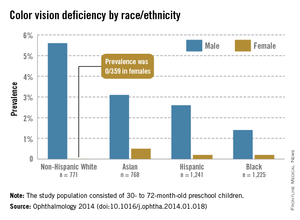Color vision deficiency was significantly more prevalent among non-Hispanic white boys than among blacks and Hispanics in a study involving more than 4,000 preschool-age children.
Prevalence among non-Hispanic white boys aged 30-72 months was 5.6%, compared with 1.4% in black boys and 2.6% in Hispanics boys. Prevalence in Asian boys was lower at 3.1%, but the difference was not significant, Dr. John Z. Xie and his associates reported (Ophthalmology 2014 [doi:10.1016/j.ophtha.2014.01.018]).
Of the 4,005 children tested, 63 were found to have color vision deficiency: 59 were boys and 4 were girls, and none of the 4 girls was white, said Dr. Xie of the Gavin Herbert Eye Institute at the University of California, Irvine, and his associates.
All of the subjects were participants in the Multi-Ethnic Pediatric Eye Diseases Study, a population-based, cross-sectional study of preschool children in Southern California. The study was supported by the National Institutes of Health and an unrestricted grant from Research to Prevent Blindness.


